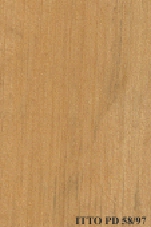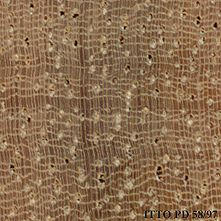
CASCA DOCE (Pradosia spp)
Trade Name
Casca doce
Scientific Name
Pradosia spp.
Family
SAPOTACEAE
Common Names
Casca Doce (Brazil); Burahém (Brazil); Abiurana-Vermelha (Brazil); Abiurana (Brazil)
Scientific Name Synonyms
Pouteria spp.
Description Of The Tree
Botanical Description
It is a very large tree, it attains heights of 30 to 40 m and diameters up to 100 cm. It is reported to present 3 to 4 buttresses, the bark exudates a sweet latex.
Natural Habitat
Pradosia trees prefer well drained soils.
Natural Distribution
Pradosia is reported in the northern South American Amazon Forest. In Brazil it is found in the Amazonas and Para states.
Wood Identification
Anatomic Description Of Wood
Vessels per mm2 more than 20 (very abundant). Tangential diameter of vessel lumina 100 micras or less (very small). Vessel-ray pits similar to intervessel pits in size and shape. Intervessel pits small, 7 micras or less. Apotracheal axial parenchyma diffuse and/or diffuse in aggregates. Occasionally axial parenchyma in continuous tangential lines (included in reticulate and scalariform). Rays more than 10 per mm (abundant). Heterogeneous rays and/or multiseriate heterogeneous rays. Silica bodies in the ray cells.
-
 Wood Macro Photo Tangential Plane
Wood Macro Photo Tangential Plane
-
 Wood Micro Photo Of Transversal Section
Wood Micro Photo Of Transversal Section
Availability
Cites Status
Unrestricted
General Wood Description
Odor
It has no characteristic odor, but occasionally bitter taste is reported.
Color
The sapwood is slightly different from the heartwood. The wood is grayish brown in color, with darker streaks.
COLOR INDEX (1=Black, 7=Light yellow,white)
5
Grain
The grain is usually straight or interlocked.
Texture
Fine to medium texture is reported in this species.
Luster
This wood is commonly of low luster.
Natural Durability
It is considered to be resistant against decay, but its resistance under exposed conditions is doubtful.
Natural durability index (1= Very high durability, 7=Vey low durability)
4
Wood Physical Properties
Basic Density or Specific Gravity (O.D. weight/vol. green) (g/cm³)
0.80
Air-dry Density (Weight and volume at 12%MC) (g/cm³)
0.91
Total shrinkage Tangential (Saturated to 0%MC) (%)
11.3
Total shrinkage Radial (Saturated to 0%MC) (%)
6.9
Drying Defects
Ease of Drying: Air seasoning is reported to be fairly rapid. Drying Defects: Risk of checking and warping is reported.
Dimensional stability ratio (Total Tangential Shrinkage %/Total Radial Shrinkage %)
1.6
Wood Chemical Properties
Wood Mechanical Properties
Bending Strength (MOR),12%MC (kgf/cm²)
1346
Compression parallel to fiber 12%MC (kgf/cm²)
571
Workability
Machining
The response of this species to machining operations is fair.
Finishing
This species is reported to be easy to finish.
REFERENCED USES
End Uses Summary
HOUSING GENERAL, TOOLS, agricultural tools, CONTAINERS, cooperage, truck bodies, truck flooring
General Housing
- 10 - Silica in Timbers
Tools
- 42 - Utilización Industrial de Nuevas Especies Forestales en el Perú.
Agricultural Tools
- 44 - Atlas of Peruvian Woods
Containers
- 50 - Properties of imported tropical woods
Cooperage
- 51 - Recopilacion de propiedades mecanicas de maderas creciendo en Chile
Truck Body
- 53 - Timbers of the New World
Truck Flooring
- 54 - Bulletin of the Government Forest Experiment Station N.157: Identification of Tropical Woods
Please Provide Information To View Producer Information